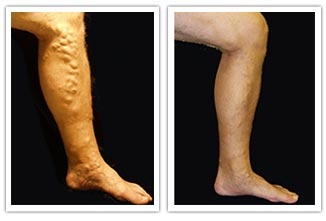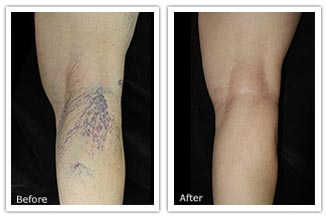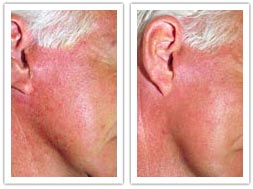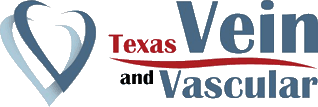Conditions We Can Help
Varicose Veins
Varicose veins are twisted, enlarged veins, often dark blue in color, near or raised above the surface of the skin. Varicose veins are often a symptom of an underlying condition called venous insufficiency.
Varicose veins do not occur suddenly. It usually takes years for signs and symptoms to develop. Genetics and inheritance usually play a role in the development of varicose veins but anyone can develop them even without a family history. If left untreated, varicose veins can cause changes to the surface of the skin which may lead to a venous leg ulcer.
Varicose veins are twisted, enlarged veins, often dark blue in color, near or raised above the surface of the skin. Varicose veins are often a symptom of an underlying condition called venous insufficiency.
Vein Cross Section -ValvesVaricose veins do not occur suddenly. It usually takes years for signs and symptoms to develop. Genetics and inheritance usually play a role in the development of varicose veins but anyone can develop them even without a family history. If left untreated, varicose veins can cause changes to the surface of the skin which may lead to a venous leg ulcer.
Varicose veins are caused by broken valves inside the vein. They are common in people that have had certain types of leg injuries or deep vein blood clots as well as people that work in jobs that require prolonged standing or sitting.
In healthy veins, one way valves direct the flow of venous blood in your leg upward, toward your heart. When one or more of these valves fails to function, then the blood flows in the reverse direction causing the veins under the skin to engorge and distend. This “backup” of blood flow can increase the pressure in your veins to a level that is three to four times the normal. This high pressure then causes the veins to bulge and stretch resulting in inflammation and pain.
Early symptoms of varicose veins include:
- Pain or a heavy feeling in the legs relieved by elevation
- Large twisted veins the buldge above the surface of the skin
- Swelling of the ankle or lower leg
- Discolored, dry, itchy skin near the ankle
- A rash or skin ulceration on the ankle or lower leg
- There may be other reasons for any one of the above symptoms, however, two or more of the symptoms at nearly the same time may be an indication of varicose veins or other venous disorders.
Possible Long-term Complications:

Varicose Vein Before AfterVaricose veins are common and are not generally associated with more severe health problems. However, they can be painful, unattractive and worsen over time. Varicose veins can cause legs and feet to swell, create a sense of fatigue in leg muscles, and throbbing and cramping at night. The skin surrounding the veins may also itch and burn. In some severe cases, venous insufficiency may develop, preventing normal blood return to the heart which can lead to problems like deep-vein thrombosis (blood clot). Patients with venous insufficiency often benefit from medical treatment. Left untreated, varicose veins can lead to swelling, increased pain, skin discoloration, and ulcerations of the lower legs. These ulcerations are difficult to treat and can become easily infected and painful. Many of these symptoms and complications can be prevented by early treatment of varicose veins.
Spider Veins
What are Spider Veins? Spider veins are red and purple blood vessels that occur in patches on the legs. The network of vessels is often as delicate as a spider’s web, which is how they get their name but they can also resemble tiny sunbursts, branching trees or may be distributed in a linear fashion on the surface of the skin.
Spider veins (referred to medically as telangectasias) and varicose veins are not the same — and one does not lead to the other. Whereas varicose veins are large, swollen and occur singularly on the legs, spider veins are delicate and tend to develop in clusters. They are, however, caused by similar factors. Spider veins appear to be hormonally induced and often are associated with pregnancy and menstruation. Although these spider veins do not produce symptoms, the feeder veins deeper in the skin may cause discomfort. Spider veins occur mostly in women, although they are also seen in men.

Exactly what happens in the body to produce spider veins isn’t known for sure, though there are several theories that address possible causes. One theory is that spider veins, which occur near the surface of the skin, are fed by underlying varicose veins too small or embedded too deeply to reach the skin surface. These underlying veins disrupt circulation, causing spider veins to grow above them. Another theory is that spider veins are little arteries that have joined the network of veins nearest the skin surface. Because arteries are highly pressurized and the surface veins have low pressure, the combination of the arterial blood (oxygenated blood flowing from the heart) with the venous blood (deoxygenated blood flowing toward the heart) causes spider veins to be visible. (see About Spider Veins or Before and After Photos below)
Spider Veins Before and AfterSpider veins do not pose a serious health threat. Though they can cause localized burning pain, aching and discomfort, spider veins are primarily a cosmetic problem. Spider veins usually take on one of three basic patterns. They may appear as thin separate lines (A); they may be arborizing and will resemble tiny branch-like shapes (B); or they may appear in a true spider web shape with a group of veins radiating outward from a dark central point (C). Linear spider veins are commonly seen on the inner knee, whereas the arborizing pattern often appears on the outer thigh in a sunburst or cartwheel distribution.

Spider veins usually take on one of three basic patterns. They may appear as thin separate lines (A); tiny branch-like shapes (B); or a true spider web shape with a central point (C). Linear spider veins are commonly seen on the inner knee, whereas the arborzing pattern often appears on the outer thigh in a sunburst or cartwheel distribution.
Spider VeinsTypically spider veins cause aching discomfort, a heavy feeling, and legs that tire easily, with symptoms often worsening as the day continues. Relief comes with walking or elevating the legs. And yet, there are many that complain of no symptoms at all. For most patients, the way to tell if you have spider veins is to simply look at your legs for signs of spider veins.
Symptoms associated with spider veins may include:
- Dull, generalized aching (especially after standing for long periods)
- Throbbing pain
- Night cramps
- Tiredness
- Burning
- Tingling
- Heaviness in legs
- Complaints may worsen with menstruation and warmer weather
Facial Telangiectasias

Facial Telangiectasias are very small spider veins that appear most commonly on the nose, cheeks, and chin. They are typically red and purple blood vessels that occur in patches.
Much like spider veins, facial telangiectasias can be influenced by hormones, but they are most often caused by prolonged sun exposure. They are common in people who have worked outside most of their lives and also in women following pregnancy or the use of hormone replacement therapy. Facial telangiectasias do not pose a serious health threat, cause no symptoms and are always considered a cosmetic problem.


